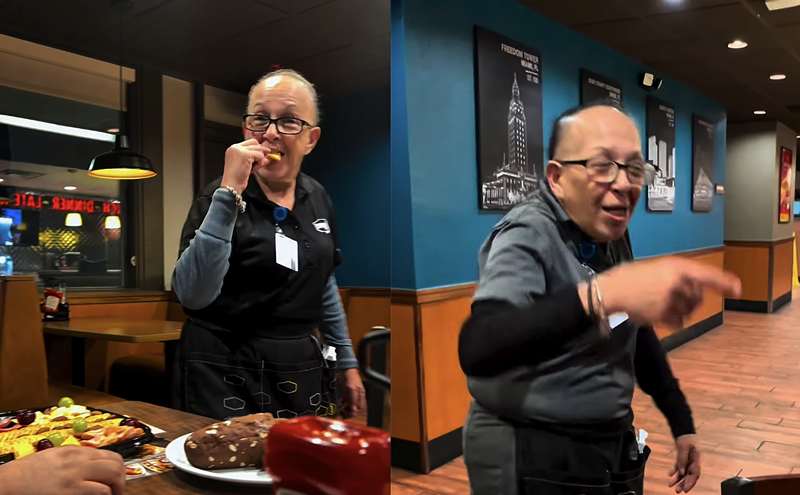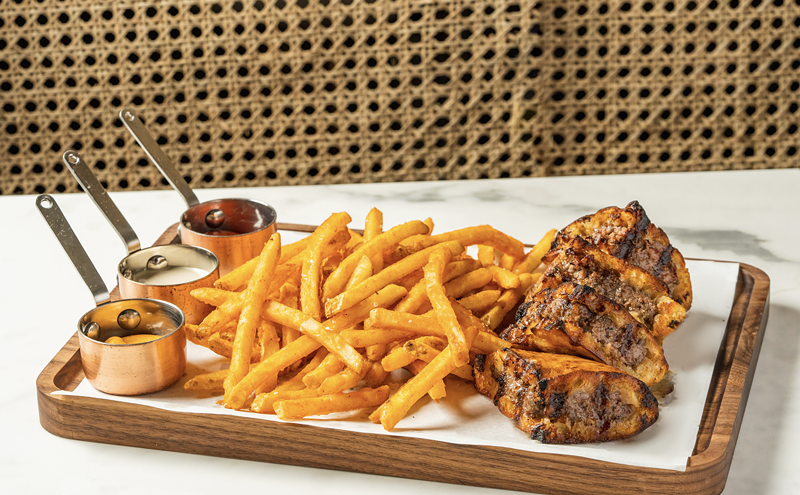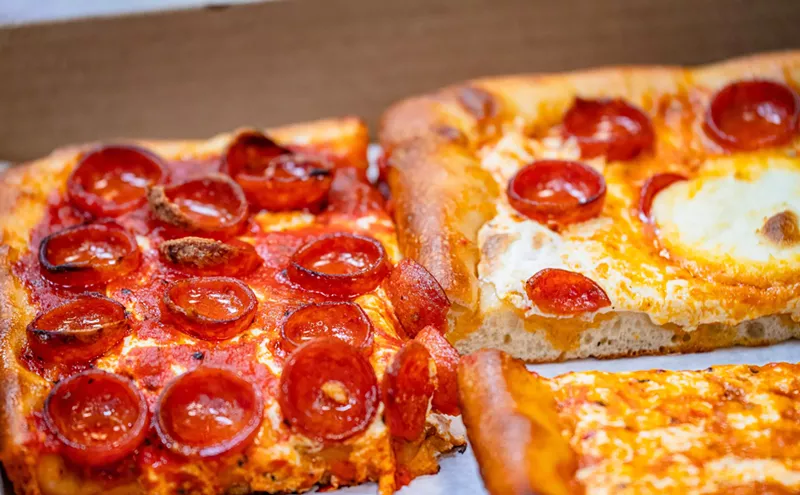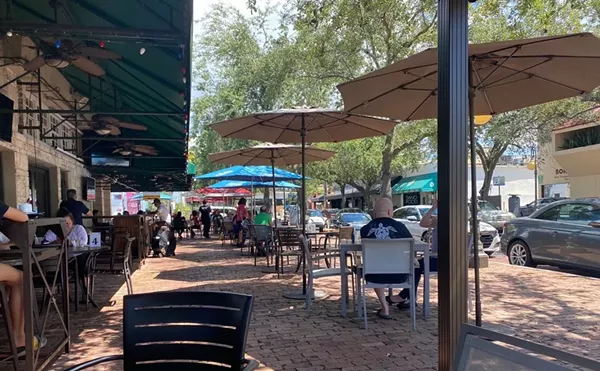"Have you been to Naoe [na-o-éh] yet?" a friend inquired a couple of months ago. A few emails followed from others asking the same question, and over the next few weeks, the 17-seat omakase oasis in Sunny Isles Beach was brought to my attention by acquaintances, colleagues, readers, and bloggers. It seemed this sort of foodie excitement hadn't been seen since South Florida's pioneers first espied mango trees. By the time Gustavo, who was busy trimming my hair, inquired whether I'd visited, I was beginning to get a little annoyed.
That evening, I finally made it to the strip mall on the east side of the 163rd Street Causeway, by Collins Avenue. Black letters on a white sign above the entrance spell Naoe, with the corresponding kanji characters below. Nowhere is the word restaurant posted; passing by in a car, one might assume the space was an import shop. So when it opened this past March, most of the patrons were friends — but shout-of-mouth has since set things in motion with the increasing momentum of a rice ball rolling down a mountain.
The softly lit room is bare-bones as can be: black tables set on black floors, comfortable white leather seating for a dozen, and unadorned tan-toned gray walls. Attention naturally gravitates to the five-seat dining bar — a thick plank of raw, smoothly sanded blond hinoki wood. More specifically, patrons peer at the man behind it — the one slicing and dicing with a cutlass-like knife. That's Kevin Cory, whose business card reads, "executive chef, general manager, and dishwasher."
Wendy Maharlika, the other half of this two-person operation, hosts, waits tables, and does everything else necessary, all in a friendly and incredibly efficient manner — more amazing yet when considering she also works what most would consider a challenging day job as assistant food and beverage director of 1 Blue Restaurant at the Regent Bal Harbour. The dynamic duo has toiled together since Cory helmed nearby Siam River in the early years of this decade, a sparkling stint that resuscitated the restaurant and did not go unnoticed by serious sushi aficionados (or by New Times, which during Cory's tenure awarded the restaurant with two consecutive Best Sushi honors).
Maharlika started us off by inquiring about food allergies and then explained that dinner for each person consists of a four-item chef's choice (omakase) bento box plus a bowl of soup on the side. Afterward, if we desired, the chef would prepare nigiri sushi for us, two pieces at a time.
We had been seated at a table, but when a two-spot opened at the bar, we switched. Eating at a sushi bar (and we'll call it this, although Naoe isn't a sushi joint) has more in common with counter service at a pub or coffee shop than any restaurant experience. A personal connection is established when watching a bartender/short-order cook/sushi artist prepare a comestible or cocktail just for you (speaking of which: Offering to buy a beer for the chef, a Japanese custom, is never a bad idea — and the short-order cook probably wouldn't mind either).
Another plus is you can observe the mastery of well-trained chefs. Cory worked in Japan at a traditional kaiseki restaurant, and his more intricate presentations here are perhaps influenced by the meticulous garnishes of that cuisine. The chef has some advantageous family ties as well: Relatives own the Naoe shoyu brewery in Oono, Japan (in operation since 1825), and different relatives run the Nakamura brewery in Ishikawa. The latter is known for producing soft, smooth sakes, including a certified organic Junmai and the Renaissance Kanazawa Junmai, made with wine yeast. Many patrons seem to order the frozen rendition of Kaga No Yukizake, which starts as a sherbert-like treat scooped with a small spoon and finishes as chilled, velvety sips. Tall flutes of Sapporo beer are on tap, and a couple of soft drink imports round out the beverages.
"It's not fresh... it's alive" is the restaurant's tag line, and indeed on any given day, Naoe might receive live scallops, mirugai, aoyagi, oysters, baigai, tokobushi, or asari flown overnight from California, Massachusetts, or other coastal states. Japanese imports include anago, unagi, and hamachi; Cory hauls in local catches from Haulover boats. Dead or alive, the seafood is always of pristine quality.
The bento is presented as a rectangular wooden vessel with a cover. It looks like the sort of box that might contain chess pieces, but traditional bento components of fish, rice, and pickled or cooked vegetables are neatly compartmentalized within. Japanese treats du jour were little silver-skinned aji, or horse mackerel (as with most fish, the smaller ones are tastiest), which Japanese fishermen discovered off the waters of New Zealand in the 1970s when they were expanding their aquatic parameters to satisfy increasing sushi demand. We watched as the chef filleted the aji; plucked a few teeny bones; brushed the firmly textured, mildly oily flesh with homemade glaze made with shoyu; flashed it under the broiler; sliced it; and plated it with pickled wasabi leaves and flowers. Freshly grated wasabi root mixed with horseradish sat on the side. You can request pure wasabi, but because the root goes for around $15 per ounce, there is a $5 to $10 surcharge — a way for Cory to keep prices down while providing quality ingredients.
A second section of the box brought meaty salmon strips, each wrapped in an opaque sheath of pickled or salted white seaweed (ugo). On the side were thin snippets of freshwater eel, roasted and lightly glazed in sauce made in-house with eel broth, sweet soy, and whatever else Cory puts in to give it a salty/savory/seductive flavor. Also squeezed into the square: a slice of lightly breaded, deep-fried shrimp tamago — a traditional sweet egg omelet often served as nigiri, but here it also contains potato and is served warm and lusciously custardy.
The final compartment holds rice molded into a decorative floral shape. On this occasion, it was flavored with shiitake mushrooms and hints of eel, with wisps of pickled daikon on top; other times, the grains might boast notes of portobello and sardines. These are not random matchups but rather the results of a knowing chef playing tastes off one another like dueling banjos (or, more aptly, dueling kotos).
The covered bowl of soup contained a dashi-based stock with parsnip, soft cubes of egg tofu, and the cress-like herb mitsuba, or Japanese wild parsley (most produce used at Naoe is organic). The price for the bento box and soup is only $26, perhaps the best American restaurant value since David Chang debuted Momofuku in New York.
We weren't finished. The chef pinched warm rice, ovally molded it in his hands, melded some melting Scottish salmon belly on top, and lightly lacquered it with syrupy shoyu-based sauce. We also tried another silver-skinned Japanese fish — the kohada — and a chilled slice of the shrimp tamago (custardy even when cold), both prepared similarly to the salmon: atop rice and brushed with shoyu. The meal was capped with a complimentary taste of cantaloupe sprinkled with sweetened rice vinegar.
Naoe had some serious timing issues in the beginning. Visualize one man preparing and plating 17 bento boxes (68 compartments) with multiple ingredients, one at a time, while also filling countless requests for nigiri. Then imagine being customer number ten or 14 or — yikes! — 17. Bentos often took up to an hour to arrive. Now a new seating system should somewhat remedy this problem. Guests making dinner reservations (accepted only through opentable.com) will have options for 7:30, 8:30, 10:30, or 11:30. Ostensibly, the 7:30 and 10:30 crowds will be nibbling their final nigiri as the respective replacement groups filter in. Still, one chef is one chef, so don't come here expecting quick bites before a show; if you're an impatient sort, you might not want to come at all. For everyone else, Naoe presents one instance where truly great things come to those who wait. But you already knew that, right?











